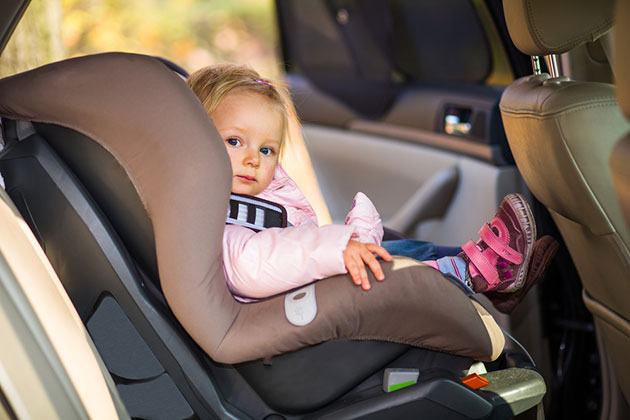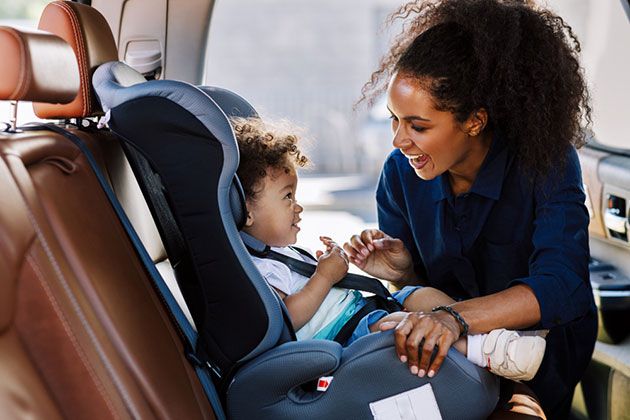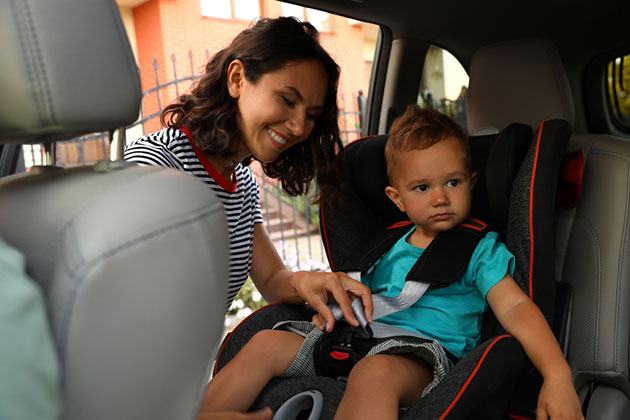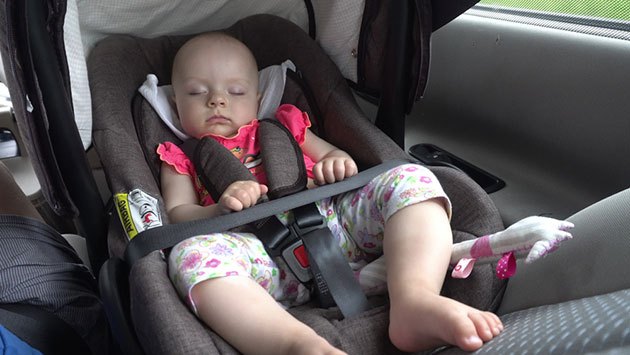When buying your first car seat, you may be perplexed and too anxious to make everything go smoothly.
But, it's completely fine! Believe me, all parents are anxious and worried at first, even those who have two or three kids, as they face new issues.
However, this is not something so scary; you just have to get a better insight into the car seat and children's safety.
That's why I will go through the necessary details and requirements until you're confident what's the safest place for car seat set up in your motor vehicle.
Are you ready? Let's begin!
More...
How to Put Car Seat in Car Safely: All You Must Know

You know that rules are different when installing a rear-facing car seat, a forward-facing car seat, or a booster seat.
The safety standards also vary according to your kids' ages and development.
But, a process installation process also depends on the type of car you have and how many car seats you're installing.
So, find more info below.
1. Maximum Car Safety Standards: Where's the Correct Installation for a Rear-facing Seat?
According to the SafeRide4Kids and National Library of Medicine research studies, all newborns, children younger than three, and children up to 3-years-old kiddos have the same car seat setup process.
In addition, the study showed that the safest car seat for a rear-facing child is the back seat of your vehicle. But what position?
Furthermore, in the research, the experts state that the center position of the back seat reduces the risk of injuries by 43%.
Also, the rear center position is the furthest place from any impacts and external forces in any type of car crash.
However, numerous experts state that most parents place their rear car seat in the rear passenger side.
Although I'm not entirely familiar with why they do so, I can only assume they want to keep an eye on the baby better. Wrong! The safest place is the center position!
Still, they always have an exception, and some of the common reasons are:
- The LATCH installation is impossible in the center
- They cannot properly install a rear-facing car seat in the center position
- The center position is just too narrow for a rear-facing car seat
- Other reasons.
My advice is to follow the rules strictly, visit the authorized centers and organizations that can help you install the rear-facing car seats in the right place, or search for a Child Passenger Safety Technician.
These people are verified experts, and they will best guide you through the installation process.
Most crucially - never install a rear seat in the front seat next to you with the airbag system on.
NEVER!
The active front airbags will hit them with maximum pressure and force, and your kid will suffer from severe injuries, and in most cases, you cannot avoid fatal consequences.
The pressure will literally smash them.
2. Where Should You Install a Forward-facing Car Seat Properly?
Concerning a forward-facing car seat and the safest installation place, it's the same as the rear-facing position.
The same study showed that a forward-facing kid should be appropriately restrained in a forward-facing child restraint system in the center position of the back vehicle seat.
And, due to research's results, both the forward-facing car seat and rear-facing position seat involved in a fatal collision, children have 13% increased chances of survival if installed in the center position.
However, if you have one child, you can place your forward-facing car seat in the middle seat.
But, if you have more children riding at the back, the middle seating position for your forward-facing car seat might not be the best option.
The main reason is that most car seats have side-impact protection benefits, working well when the car seats remain in the forward-facing position.
So, children seated with no protection at all should be sitting in the middle, and children seated in forward-facing seats should be positioned on the outer seats of the back car seat.
3. What About a Convertible Car Seat and a Booster Seat?
The main point regarding the booster seat and a convertible car seat is to follow the manufacturer's instructions again, consult CPTs, and other experts to help you when installing the car safety seats.
However, for both the booster seat and convertible car seat, it would also be best if the child sits in the middle position, where you have a lap and shoulder belt.
However, you still need to check the part of the child's seat before every use.
Hence, you must take your booster and convertible car seat for an inspection to a child safety inspection station or other car seat safety organization to make sure all of the car seats - rear-facing seats, forward-facing car seats, convertible car seats, and booster seats are correctly installed.
4. When Is the Center Not the Best Location for Car Seats?

When you cannot install the car seats correctly, safely, and with maximum stability, the middle seat is NO longer the safest position.
So if you're confused a bit, let me put it in other words: It's better to have a safe installation than placing your child into the center position.
So, if the installation in the center part is too complicated, and you struggle, change it.
For example, pick the passenger side seating position to get a better installation process.
5. What About the Latch Installation System?
Numerous cars have LATCH connectors for two side seating positions in the back seat.
Thus, you might not always use the lower anchor from both sides to install a car seat with the LATCH attachments in the center.
So, if you cannot install the car seat with the LATCH properly, you can use the seat belts in the center, even if it's simply a lap-only seat belt.
I like LATCH installation since it's easier to install a car seat correctly, but it doesn't provide more safety than the regular seat belt system.
But, you can use a tether strap for extra stability for your children.
6. The Safest Place for a Car Seat in an SUV or a Minivan
Where you should place your car seat in these two types of vehicles depends on numerous factors.
Firstly, you need to check whether your SUV or minivan has third-row seating, so you want your baby as close to the middle as possible.
If the vehicle contains a bench in the middle row, you should install the car seat in the center part of this middle row.
However, if the middle row offers bucket seats, you should put the car seat in the third row of seats.
7. Yet, What if You Install More Than One Car Seat?
Firstly, if SUVs or minivans have bench seats in both back rows, install car seats in the center of each row.
Secondly, if you install two car seats in a vehicle with buckle seats, install car seats in the center of each row.
Next, install a car seat in the middle row in the passenger seat. If you need to install another car seat, place it in the back row in the passenger seat.
However, the rules change according to the car seat types - rear-facing and forward-facing car seats.
But, I'll explain it later.
8. What if One Kid Is Safe in the Center, but Child Number Two Is on the Way?
It's okay, here's the deal:
1. Place the child rear-facing in the center since they're most vulnerable in the crash
2. Put the forward-facing kid in the center seat as the infant car seat overall gives more security to your kid
The first situation, here we go:
- The majority of car crashes are frontal ones
- The center position is a top one for rear-facing seats in rare but most dangerous for side-impact crashes
- In frontal impacts, the infant seats are the safest, as they keep the baby's head, neck, and back supported and stable.
Of course, there are always exceptions, but you can use your CPSTs for more explanation and different stances.
9. What if You Cannot Put the Rear-facing and the Forward-facing Convertible Seat Together?

You will have to use two outside seats.
There's no difference between a driver's and passenger's side in collision statistics, so there's no difference for the rear-facing child's car seat.
But, the only variable would be if you street park and your child who needs more time to buckle needs to be on the passenger side.
10. Fitting Three Across: What's the Issue?
Well, the dame goes as with two car seats.
The main issue is whether three car seats can fit across the rear-facing position in your vehicle.
But, the market is full of numerous narrow car seats, or you can even try a RideSafer Travel Vest.
And, what if you have an older child who doesn't need a car seat?
Once they overgrow the child's car seat, in this case, an all-in-one-seat booster with harness straps, belt-positioning booster seat, or backless booster, kids must remain in the back seat buckled with the shoulder seat belts and lap belt until they're 13.
Once they're 13, they can sit in the front passenger seat with the adult seat belt, where the lap belt covers their upper thighs, and the shoulder belt crosses their shoulder and chest.
11. Does the Car Seat Go Behind the Driver or Passenger?
It doesn't really make much difference but, you should ONLY install your car seat behind these seats if:
1. You have more than one car seat that requires installation
2. When your child is riding in a forward-facing seat, but you have another one that doesn't need a car seat
And, if you have to use outer seats, you should place the car seat behind the passenger seat.
But, again, the main reason is a crash.
The driver's side and car seat will be severely injured in such events.
But if you install two car seats, both rear-facing convertible or forward-facing, place one child in the middle and the older child behind the passenger seat.
The older kid will be physically stronger to endure the impact.
The same goes for twins.
But if one car seat is rear-facing and the other is forward-facing, place the second in the middle, and the rear-facing one goes behind the passenger seat.
Forward-facing children do not have full safety features as rear-facing ones.
So, they should remain rear-facing as long as possible.
Read more —
A Quick Reminder
1. Newborn & Infant Seats
a. Infant seats are suitable for 9-18 months old children, keeping the child's head, neck, and back supported, only for the rear position.
Kids should use them until they reach the maximum weight limit and switch to the rear all-in-one seat or rear convertible.
b. Convertible seats for 40-60 pounds kids for rear and forward-facing positions with harness straps for more security.
Please keep them in rear positions until their height and weight limits overpass the maximum.
c. All-in-one seats - 3-in-one design for the rear, forward-facing, and booster seats.
2. Toddlers & Preschoolers Seats
- Convertible seats - for 2-4 years old kids
- All-in-one seats - keep kids in rear position until their height and weight limits outreach the recommendations
3. School-aged Kiddos Seats
- All-in-one car seats - for all positions and more extended rear use
- Booster seats - highback belt-positioning, backless or harness booster - until they're ready for seat belt (4 feet 9 inches tall, and 13 years old)
Avoiding Common Mistakes

- Getting a used seat without any inspection - WRONG!
- Putting a seat in the wrong place
- Improper installation or buckling up (correct: the shoulder belt covers chest and shoulder, the lap belt lies low on the upper thighs, not stomach)
- The movement to a forward-facing seat too soon
- Reclining children at an inadequate angle
- The movement to a booster seat too soon
- Incorrect use of boosters
- Quick transition to seat belt systems
- Not removing the kid's outerwear when buckling them
Do not make such simple yet so dangerous mistakes!!!
Please keep your child in the proper restraint systems until their height, and weight limit overpasses the recommended one.
Please make sure the head rest and back recline fully and correctly to keep them comfortable and pressure-free.
Ensure the chest clip lies in the correct position with the harness straps.
Be confident you correctly and fully attach the chest clip and crotch buckle to provide complete security and stability.
Check your progress once again.
FAQs
Should the car seat go behind the driver or passenger?
It depends on your child's age and car seat safety types.
Older kids go in the center seat and younger behind the passenger seats when you have older and younger kids.
If you have twins or the same car seats, one goes behind the passenger, another in the center seat.
What side of the car should the car seat be on?
It's better to place them behind the passenger seat or the center seat.
However, don't place them behind the driver since that side will be crushed in a moderate or severe crash.
Should the car seat go in the middle or side?
The safest place is the middle one, if possible. Side is the second-best place, but behind the passenger, not the driver.
Can you put two car seats next to each other?
Yes, if your car allows it.
Sometimes, you can place them in the middle or back row, but most car seats allow them to be installed next to each other.
So, one goes in the center, another behind the passenger.
Final Thoughts
So, we found that the safest place for a car seat is the center position of the back seat!
However, the second-best is behind the passenger when the conditions dictate that arrangement.
It's essential to stick to the rules and consult experts and CPSTs if you have issues. Get your car seat safety inspected in the verified stations.
Don't act on your own!
For additional questions, leave a comment below. I'm always there for you!
